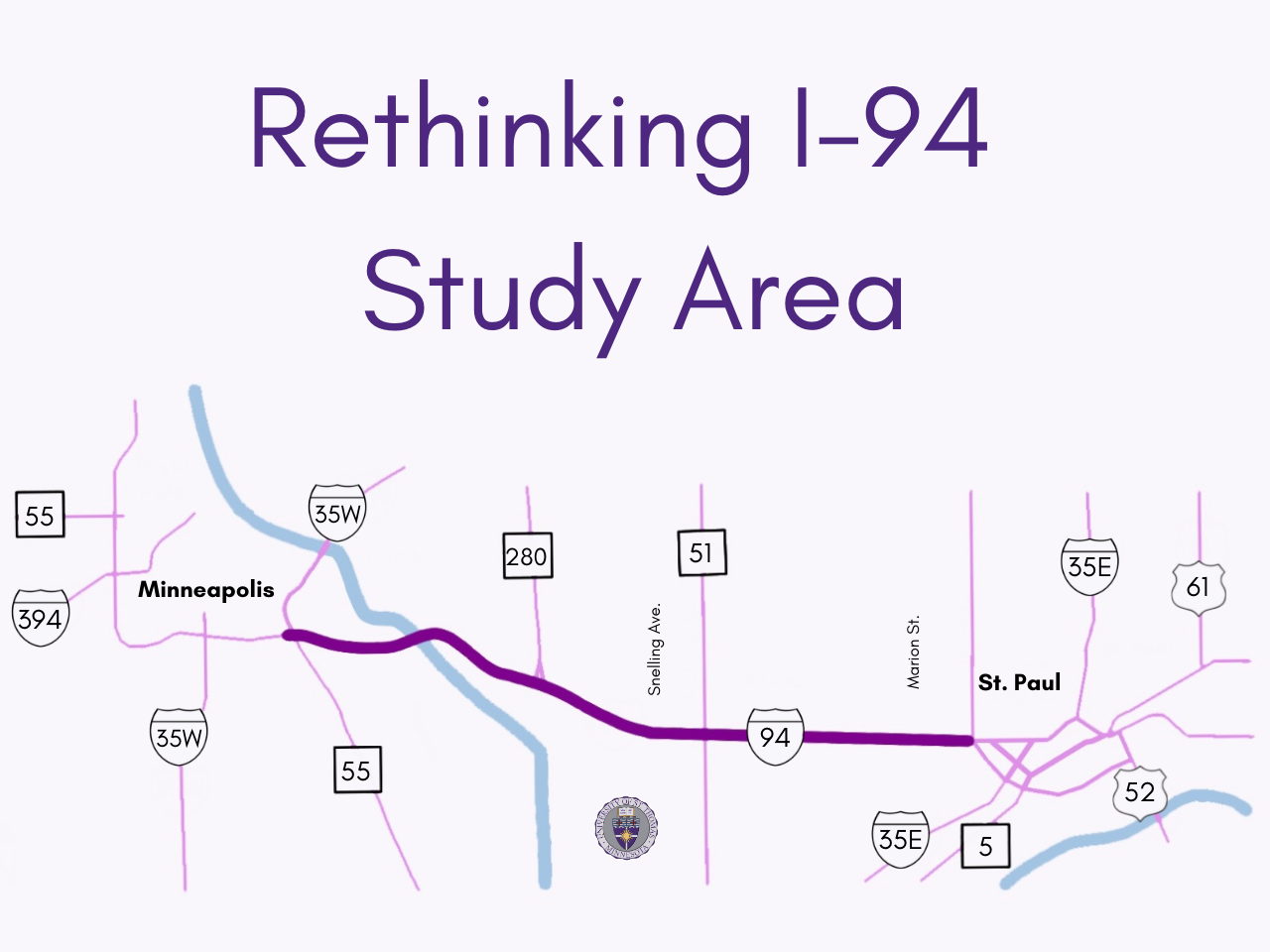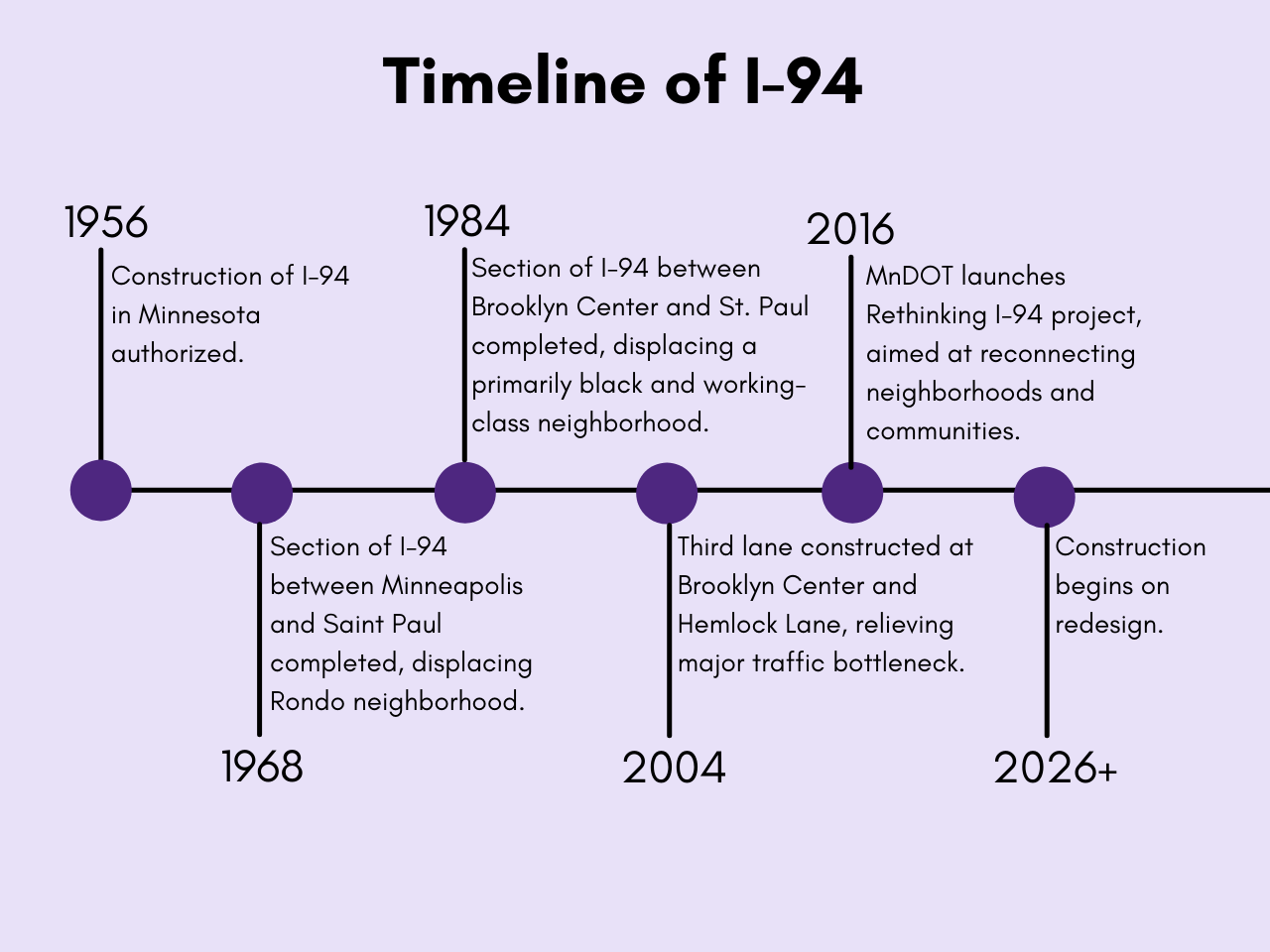The Minnesota Department of Transportation is considering changes to the Twin Cities’ busiest highway, used daily by 150,000 travelers, with its “Rethinking I-94” project, including a widely supported proposal to replace Interstate 94 with a regular surface street.
I-94 destroyed homes and disconnected neighborhoods when it was built in the 1950s and ‘60s and has been a source of traffic congestion and accidents since. Many residents are calling on the Minnesota Department of Transportation to reimagine the highway and revitalize the communities it intersects.
“The work we did to construct the 94 corridor devastated many communities, and we intend to do better and want to do better,” MnDOT Corridor Director for “Rethinking I-94” Sheila Kauppi said.
Hundreds of homes and businesses were eliminated when the roadway was constructed, which led to “a pattern of community distrust” with MnDOT, according to the department.
“We are coming to grips with the wrongs that were done to communities in the paths of these highways,” said Barb Thoman, former chair of the Union Park District Council’s Transportation Committee.
Several communities, including the Rondo neighborhood along I-94 between Rice Street and Lexington Avenue, were torn apart by the construction of the interstate. The Rondo neighborhood once housed the majority of African American residents in St. Paul, as well as many businesses and community organizations.
“The consequences in the Rondo neighborhood were just dramatic and horrible and ongoing,” Thoman said.
I-94 is also a source of traffic congestion, frequent accidents and noise pollution along the interstate. As part of “Rethinking I-94,” MnDOT is searching for solutions that would spread out traffic going through the cities.
“There’s always accidents, almost every morning,” first-year commuter student Abbey O’Brien said. “I leave 30 to 40 minutes early and I still end up late.”
“Rethinking I-94” was officially launched in 2016 with a two-year “technical research” phase. MnDOT used engagement activities to figure out what was important to the communities between St. Paul and Minneapolis.
Several possibilities are being considered by MnDOT and converting the interstate into a business-lined boulevard is one widely supported proposal. Ideally, this would reignite the damaged communities along the interstate.
“Rethinking I-94 was really this long-term effort to engage the people who live, work and play along the corridor,” Kauppi said. “We intend to develop and execute a community-based approach that will focus on reconnecting neighborhoods and revitalizing communities.”
This approach takes time and lots of consideration on MnDOT’s part, however. According to Kauppi, MnDOT is currently revising its initial draft of goals and criteria based on community feedback. The revised document is intended to be released this summer.
“The biggest challenge right now is making sure what we embark upon includes all of the voices, and not just those that are loudest,” Kauppi said.
Kauppi described “Rethinking I-94” as a “program of projects,” meaning the eventual solution will include more than just construction on I-94 and will involve many facets of community and industry.
“It might be things such as capacity building in our workforce development so that we have the workforce from the community ready to work on the project,” Kauppi said.
Senior commuter student and commuter mentor Madison Schwanke said she believes a boulevard could be a viable step towards rebuilding the communities that were damaged by I-94.
“I think we all need a little more community in this world,” Schwanke said. “If that means putting a community back to how it was originally, then I’m all for it.”
Schwanke noted that this change could negatively affect St. Thomas commuter students, however, and that closing I-94 could flood residential areas with traffic, creating safety and noise pollution issues.
“I know that the impact would be really heavy on the students who choose to commute,” Schwanke said. “If you start resorting to the neighborhoods because I-94 is under construction, I believe the neighborhoods will suffer for that period of time.”
I-94 was constructed to direct traffic into and through the Twin Cities’ highly concentrated downtown areas, but some believe it is unnecessary now that urban sprawl has pushed businesses and residents away from the heart of the cities.
Thoman thinks that I-94 has lost its necessity in the Twin Cities.
“That stretch of roadway is nearing the end of its useful life,” Thoman said. “(MnDOT) needs to figure out what they are going to do next.”
Kauppi is excited that the community is voicing its thoughts regarding I-94, and said that listening to community members is an integral part of the “Rethinking I-94” initiative.
“There’s people talking to us, which is important, because we want to make sure we do it right,” Kauppi said.
Derek Badger can be reached at badg7629@stthomas.edu.




